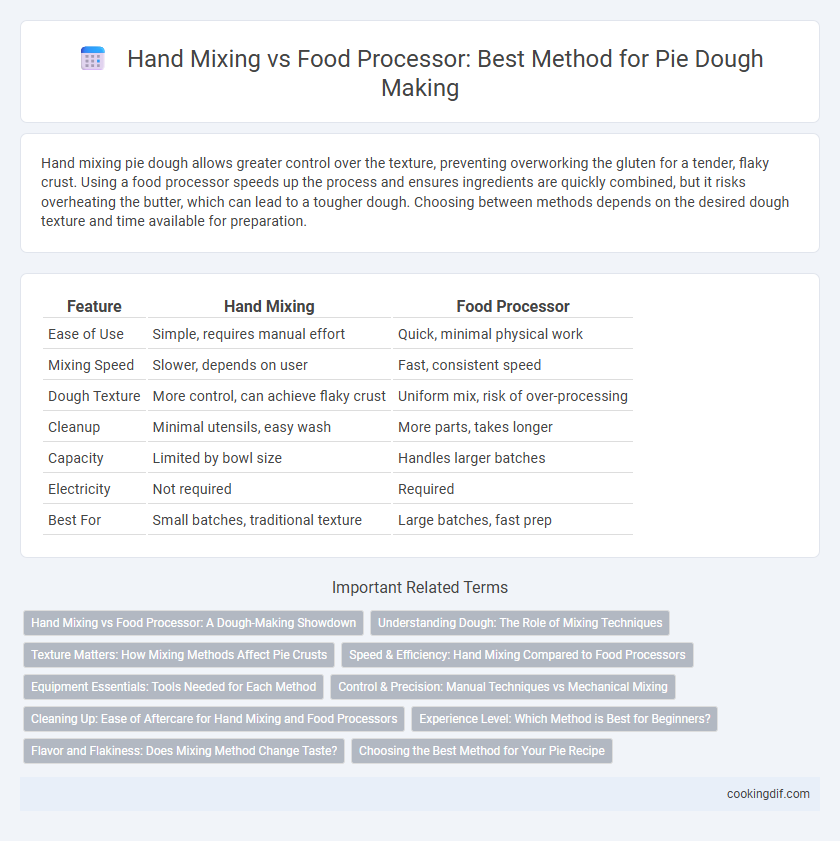Hand mixing pie dough allows greater control over the texture, preventing overworking the gluten for a tender, flaky crust. Using a food processor speeds up the process and ensures ingredients are quickly combined, but it risks overheating the butter, which can lead to a tougher dough. Choosing between methods depends on the desired dough texture and time available for preparation.
Table of Comparison
| Feature | Hand Mixing | Food Processor |
|---|---|---|
| Ease of Use | Simple, requires manual effort | Quick, minimal physical work |
| Mixing Speed | Slower, depends on user | Fast, consistent speed |
| Dough Texture | More control, can achieve flaky crust | Uniform mix, risk of over-processing |
| Cleanup | Minimal utensils, easy wash | More parts, takes longer |
| Capacity | Limited by bowl size | Handles larger batches |
| Electricity | Not required | Required |
| Best For | Small batches, traditional texture | Large batches, fast prep |
Hand Mixing vs Food Processor: A Dough-Making Showdown
Hand mixing pie dough allows for greater control over texture, preventing overworking gluten and ensuring a tender, flaky crust, while a food processor offers speed and efficiency by quickly cutting fat into flour evenly. The food processor's rapid mixing reduces manual effort but risks overheating the fat, which can result in a tougher crust if not carefully monitored. Choosing between hand mixing and a food processor depends on balancing time constraints with desired crust quality for optimal pie dough preparation.
Understanding Dough: The Role of Mixing Techniques
Hand mixing allows precise control over dough texture by gently combining ingredients, preserving gluten structure and preventing overworking, which is essential for tender, flaky pie crusts. Food processors offer speed and consistency, rapidly incorporating fat into flour, but can risk overheating or overmixing, leading to tougher dough if not carefully monitored. Understanding the impact of these mixing techniques on gluten development and fat distribution helps bakers achieve optimal pie crust quality tailored to their preferred texture.
Texture Matters: How Mixing Methods Affect Pie Crusts
Hand mixing pie dough preserves larger fat particles, resulting in a flakier, more tender crust due to uneven fat distribution that creates air pockets during baking. Food processors cut fat more uniformly, leading to a denser, less flaky texture as the dough becomes overworked and heat from the blade warms the fat prematurely. Optimal pie crust texture relies on minimal mixing to maintain cold, intact fat pieces, making hand mixing superior for achieving a delicate, flaky crust.
Speed & Efficiency: Hand Mixing Compared to Food Processors
Hand mixing pie dough offers greater control over texture, preventing overworking the gluten, but it is slower and requires more physical effort compared to food processors. Food processors significantly increase speed and efficiency by quickly cutting fat into flour, resulting in a consistent dough with minimal manual labor. For large batches or time-sensitive baking, food processors optimize workflow, while hand mixing remains preferred for delicate, artisanal doughs.
Equipment Essentials: Tools Needed for Each Method
Hand mixing dough requires minimal equipment, typically a large mixing bowl, a sturdy wooden spoon or dough whisk, and clean hands to achieve proper dough consistency. Using a food processor necessitates a machine with a metal blade attachment, a chilled metal or glass bowl, and ideally, a pastry cutter blade for precise dough mixing and swift incorporation of butter or shortening. While hand mixing allows tactile control over dough texture, a food processor streamlines the process, offering speed and uniformity, especially crucial in maintaining butter pieces cold for flaky pie crusts.
Control & Precision: Manual Techniques vs Mechanical Mixing
Hand mixing dough offers superior control and precision, allowing bakers to feel the texture and adjust hydration and consistency in real-time, which is crucial for delicate pie crusts. Mechanical mixing with a food processor speeds up the process but can easily overwork the dough, leading to toughness due to excessive gluten development. For optimal pie crust quality, manual techniques ensure finer control over dough temperature and texture, preserving tenderness and flakiness.
Cleaning Up: Ease of Aftercare for Hand Mixing and Food Processors
Hand mixing dough requires minimal cleanup, typically involving just a bowl and a spoon or whisk, which can be quickly rinsed or placed in a dishwasher. Food processors involve more components such as blades, lids, and bowls, each needing thorough washing to prevent dough residue buildup and maintain hygiene. Opting for hand mixing can save time in aftercare, while food processors demand more detailed cleaning routines to ensure longevity and performance.
Experience Level: Which Method is Best for Beginners?
Hand mixing pie dough allows beginners to develop a tactile understanding of dough texture and flour incorporation, enhancing their baking skills. Food processors speed up the process but can easily overwork the dough, leading to tougher crusts, making them less forgiving for those new to baking. For novices, hand mixing offers better control and a more intuitive learning experience, essential for mastering the perfect pie crust.
Flavor and Flakiness: Does Mixing Method Change Taste?
Hand mixing pie dough preserves the integrity of fat pieces, resulting in a flakier texture and enhanced buttery flavor compared to a food processor. Food processors quickly combine ingredients but can overwork the dough, leading to a denser crust with less distinct layers and muted taste. The gentle, tactile approach of hand mixing allows better control over dough consistency, directly influencing the pie's overall flavor and flakiness.
Choosing the Best Method for Your Pie Recipe
Hand mixing dough allows greater control over texture and prevents overworking, resulting in a tender, flaky pie crust. A food processor speeds up the process and efficiently cuts fat into flour but risks overheating and toughening the dough if pulse timing is not managed carefully. Select hand mixing for delicate recipes needing precise texture and opt for a food processor when time efficiency and consistency are priorities.
Hand mixing vs food processor for dough making Infographic

 cookingdif.com
cookingdif.com